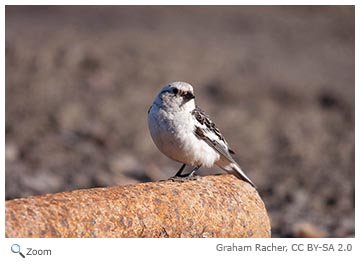Calcariidae - Longspurs, Snow Buntings
|
|
|
|
 There are six species of migratory birds in this family. The snow bunting and Lapland longspur are found in North America and Eurasia. The other four species are only found in North America. There are six species of migratory birds in this family. The snow bunting and Lapland longspur are found in North America and Eurasia. The other four species are only found in North America.
The birds in this family have brown, gray and white plumage. They eat seeds, grasses and insects.
Longspurs get their name from the long claw on their hind toe.
The birds in this family were once in the Emberizidae family, but DNA analysis has shown that similarities are superficial and not genetic.
World Status Key
 Least Concern Least Concern  Near Threatened Near Threatened  Vulnerable Vulnerable  Endangered Endangered  Critically Endangered Critically Endangered  Extinct in Wild Extinct in Wild  Extinct Extinct  Not Enough Data Not Enough Data
Status and range is taken from ICUN Redlist.
U.S. Status Key
 Threatened in US Threatened in US  Endangered in US Endangered in US  Introduced Introduced
Status taken from US Fish and Wildlife. Click on U.S. status icon to go to the U.S. Fish and Wildlife species profile. |
|
New Hampshire Status Key
 Threatened in NH Threatened in NH  Endangered in NH Endangered in NH  Breeds in NH (birds) Breeds in NH (birds)
Status taken from NH Fish and Game |
Location Key
 Africa Africa  Asia Asia  Australia/Oceania Australia/Oceania  Europe Europe  North America North America  South America South America  NH NH  Click for More Info Click for More Info  Click for Image Click for Image
Other Species Around the World
|
| None |
|
|
Additional Information
Key:  Profile Profile  Photos Photos  Video Video  Audio Audio
Lapland Longspur -Calcarius lapponicus       
The Lapland longspur breeds in the Arctic tundra.
Source: Cornell Lab of Ornithology Intended Audience: General Reading Level: Middle School
Lapland Longspur -Calcarius lapponicus       
The Lapland longspur forages on the ground for seeds and insects.
Source: National Audubon Society Intended Audience: General Reading Level: Middle School
Snow Bunting - Plectrophenax nivalis        
The snow bunting breeds in the Arctic tundra.
Source: Arkive Intended Audience: General Reading Level: Middle School
Snow Bunting - Plectrophenax nivalis       
The snow bunting is also know as "snowflakes" because of their white plumage.
Source: Cornell Lab of Ornithology Intended Audience: General Reading Level: Middle School
Snow Bunting - Plectrophenax nivalis      
The snow bunting migrates in large flocks.
Source: Animal Diversity Web Intended Audience: General Reading Level: Middle School
Smith's Longspur - Calcarius pictus     
Smith's longspur breeds in Alaska and northern Canada. It winters in Iowa, Missouri, Arkansas, Louisiana, Oklahoma, Texas and Kansas.
Source: Cornell Lab of Ornithology Intended Audience: General Reading Level: Middle School
Smith's Longspur - Calcarius pictus     
Smith's longspur breed in colonies. and the female may mate with more than one male.
Source: National Audubon Society Intended Audience: General Reading Level: Middle School
Chestnut-collared Longspur - Calcarius ornatus   
The chestnut collared longspur is breeds in the prairies of Canada and Great Plains of the United States. It winters as far south as Mexico.
Source: Animal Diversity Web Intended Audience: General Reading Level: Middle School
Chestnut-collared Longspur - Calcarius ornatus     
During the breeding season the male chestnut collared longspur has a black belly.
Source: Cornell Lab of Ornithology Intended Audience: General Reading Level: Middle School
Mckay's Bunting - Plectrophenax hyperboreus    
McKay's bunting nests on remote St. Matthew and Hall Islands in the Bering Sea. It winters along the west Alaska coast.
Source: National Audubon Society Intended Audience: General Reading Level: Middle School
McCown's Longspur - Rhynchophanes mccownii      
McCown's longspur breeds in the Great Plains. It winters as for south as Mexico. It is also found in Manitoba and Alberta, Canada.
Source: Cornell Lab of Ornithology Intended Audience: General Reading Level: Middle School
McCown's Longspur - Rhynchophanes mccownii     
McCown's longspur eats seeds and insects. It forages on the ground for its food and will flush out insects and chase them down.
Source: National Audubon Society Intended Audience: General Reading Level: Middle School
|

